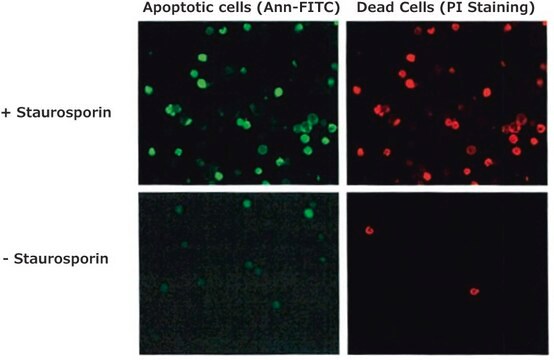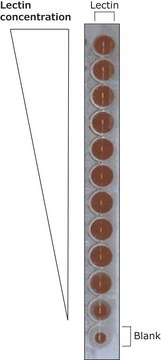A9460
Annexin V from human placenta
≥90% (SDS-PAGE), buffered aqueous solution
Synonym(s):
Annexin V, Calphosbindin I, Lipocortin V, PAP-1
About This Item
Recommended Products
biological source
human placenta
Quality Level
Assay
≥90% (SDS-PAGE)
form
buffered aqueous solution
mol wt
33 kDa (four subunits)
technique(s)
cell based assay: suitable
impurities
Human Source(HCV), tested negative
solubility
water: soluble
suitability
suitable for molecular biology
UniProt accession no.
shipped in
dry ice
storage temp.
−70°C
Gene Information
human ... ANXA5(308)
Looking for similar products? Visit Product Comparison Guide
General description
Annexin V is a calcium-dependent phospholipid-binding protein. It is expressed in high concentration in cells with barrier functions, such as vascular endothelium, epithelial cells in bile ducts, placental trophoblasts, mammary ducts, renal tubules, and nasal epithelium.
Application
- to verify the involvement of phosphatidylserine in adhesion using flow cytometry
- to test adhesion specificity of phosphatidylserine
- for synthesis of NIR700-Annexin-V imaging probe
- in dynamic light scattering (DLS) assay to test the effects of various treatments on virion aggregation
Biochem/physiol Actions
Packaging
Physical form
Storage Class Code
12 - Non Combustible Liquids
WGK
WGK 2
Flash Point(F)
Not applicable
Flash Point(C)
Not applicable
Certificates of Analysis (COA)
Search for Certificates of Analysis (COA) by entering the products Lot/Batch Number. Lot and Batch Numbers can be found on a product’s label following the words ‘Lot’ or ‘Batch’.
Already Own This Product?
Find documentation for the products that you have recently purchased in the Document Library.
Customers Also Viewed
Our team of scientists has experience in all areas of research including Life Science, Material Science, Chemical Synthesis, Chromatography, Analytical and many others.
Contact Technical Service





